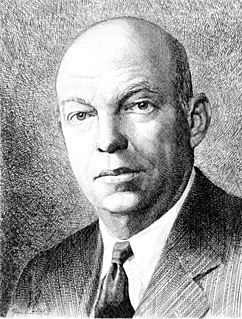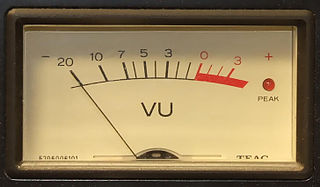
Edwin Howard Armstrong was an American electrical engineer and inventor, who developed FM radio and the superheterodyne receiver system. He held 42 patents and received numerous awards, including the first Medal of Honor awarded by the Institute of Radio Engineers, the French Legion of Honor, the 1941 Franklin Medal and the 1942 Edison Medal. He was inducted into the National Inventors Hall of Fame and included in the International Telecommunication Union's roster of great inventors. Armstrong attended Columbia University, and served as a professor there for most of his life.

A radiotelephone, abbreviated RT, is a radio communication system for transmission of speech over radio. Radiotelephony means transmission of sound (audio) by radio, in contrast to radiotelegraphy, which is transmission of telegraph signals, or television, transmission of moving pictures and sound. The term may include radio broadcasting systems, which transmit audio one way to listeners, but usually refers to two-way radio systems for bidirectional person-to-person voice communication between separated users, such as CB radio or marine radio. In spite of the name, radiotelephony systems are not necessarily connected to or have anything to do with the telephone network, and in some radio services, including GMRS, interconnection is prohibited.
Dead air is an unintended period of silence that interrupts a broadcast during which no audio or video program material is transmitted.
The Institute of Radio Engineers (IRE) was a professional organization which existed from 1912 until December 31, 1962. On January 1, 1963 it merged with the American Institute of Electrical Engineers (AIEE) to form the Institute of Electrical and Electronics Engineers (IEEE).

A volume unit (VU) meter or standard volume indicator (SVI) is a device displaying a representation of the signal level in audio equipment. The original design was proposed in the 1940 IRE paper, A New Standard Volume Indicator and Reference Level, written by experts from CBS, NBC, and Bell Telephone Laboratories. The Acoustical Society of America then standardized it in 1942 for use in telephone installation and radio broadcast stations. Consumer audio equipment often features VU meters, both for utility purposes and for aesthetics.
The Audio Engineering Society (AES) is a professional body for engineers, scientists, other individuals with an interest or involvement in the professional audio industry. The membership largely comprises engineers developing devices or products for audio, and persons working in audio content production. It also includes acousticians, audiologists, academics, and those in other disciplines related to audio. The AES is the only worldwide professional society devoted exclusively to audio technology.

WRGB is a television station licensed to Schenectady, New York, United States, serving the Capital District as an affiliate of CBS. It is owned by Sinclair Broadcast Group alongside CW affiliate WCWN. Both stations share studios on Balltown Road in Niskayuna, New York, while WRGB's transmitter is located on the Helderberg Escarpment west of New Salem.

RIAA equalization is a specification for the recording and playback of phonograph records, established by the Recording Industry Association of America (RIAA). The purposes of the equalization are to permit greater recording times, to improve sound quality, and to reduce the groove damage that would otherwise arise during playback.
George Harold Brown was an American research engineer. He was a prolific inventor who held more than 80 patents and wrote over 100 technical papers.
CBS Laboratories or CBS Labs was the technology research and development organization of the CBS television network. Innovations developed at the labs included many groundbreaking broadcast, industrial, military, and consumer technologies.

Alfred Norton Goldsmith was a noted American electrical engineer.

John Vincent Lawless Hogan, often John V. L. Hogan, was a noted American radio pioneer.
Arthur V. Loughren was an American electrical engineer who played a prominent role in the development of NTSC television.

John Kenneth Hilliard was an American acoustical and electrical engineer who pioneered a number of important loudspeaker concepts and designs. He helped develop the practical use of recording sound for film, and won an Academy Award in 1935. He designed movie theater sound systems, and he worked on radar as well as submarine detection equipment during World War II. Hilliard collaborated with James B. "Jim" Lansing in creating the long-lived Altec Voice of the Theatre speaker system. Hilliard researched high-intensity acoustics, vibration, miniaturization and long-line communications for NASA and the Air Force. Near the end of his career, he standardized noise-control criteria for home construction in California, a pattern since applied to new homes throughout the U.S.

Audio magazine was a periodical published from 1947 to 2000, and was America's longest-running audio magazine. Audio published reviews of audio products and audio technology as well as informational articles on topics such as acoustics, psychoacoustics and the art of listening. Audio claimed to be the successor of Radio magazine which was established in 1917.
Gerhard Steinke is a German sound engineer.
Donald Glen Fink was an American electrical engineer, a pioneer in the development of radio navigation systems and television standards, vice president for research of Philco, president of the Institute of Radio Engineers, General Manager of the IEEE, and an editor of many important publications in electrical engineering.
Albert Neville Thiele, OAM, was an Australian audio engineer. Thiele was born in Brisbane, Australia. He was particularly noted for his work on electronic filters and on developing the Thiele/Small parameters for characterising loudspeakers as an aid to loudspeaker cabinet design.
John Ernest Benson (1911-1989) was an Australian engineer and researcher who contributed to studies on piezoelectric crystals, television and sound systems, particularly loudspeakers.

The Aiken code is a complementary binary-coded decimal (BCD) code. A group of four bits is assigned to the decimal digits from 0 to 9 according to the following table. The code was developed by Howard Hathaway Aiken and is still used today in digital clocks, pocket calculators and similar devices.










